University Accounting Report: Enron's Financial Reporting and Analysis
VerifiedAdded on 2023/06/04
|12
|2982
|311
Report
AI Summary
This report provides an in-depth analysis of Enron's financial reporting practices, focusing on the misuse of mark-to-market accounting, the role of special purpose entities (SPEs), and the impact of the stock option compensation scheme on the company's downfall. The report examines how Enron's management manipulated mark-to-market accounting to present a misleadingly positive financial picture, particularly in its natural gas business. It also explores how SPEs were used to hide debts and circumvent accounting regulations, and how the stock option scheme incentivized executives to prioritize short-term gains over the long-term health of the company, all based on agency theory. The second part of the report takes a practical reference from Telstra Corporation's annual report to describe and analyze the five elements of financial statements defined in the International Financial Reporting Standards: assets, liabilities, revenue, expenses, and equity, and their measurement methods. The report also critically analyzes the measurement methods used by the company to value its bond liabilities and interest expenses.
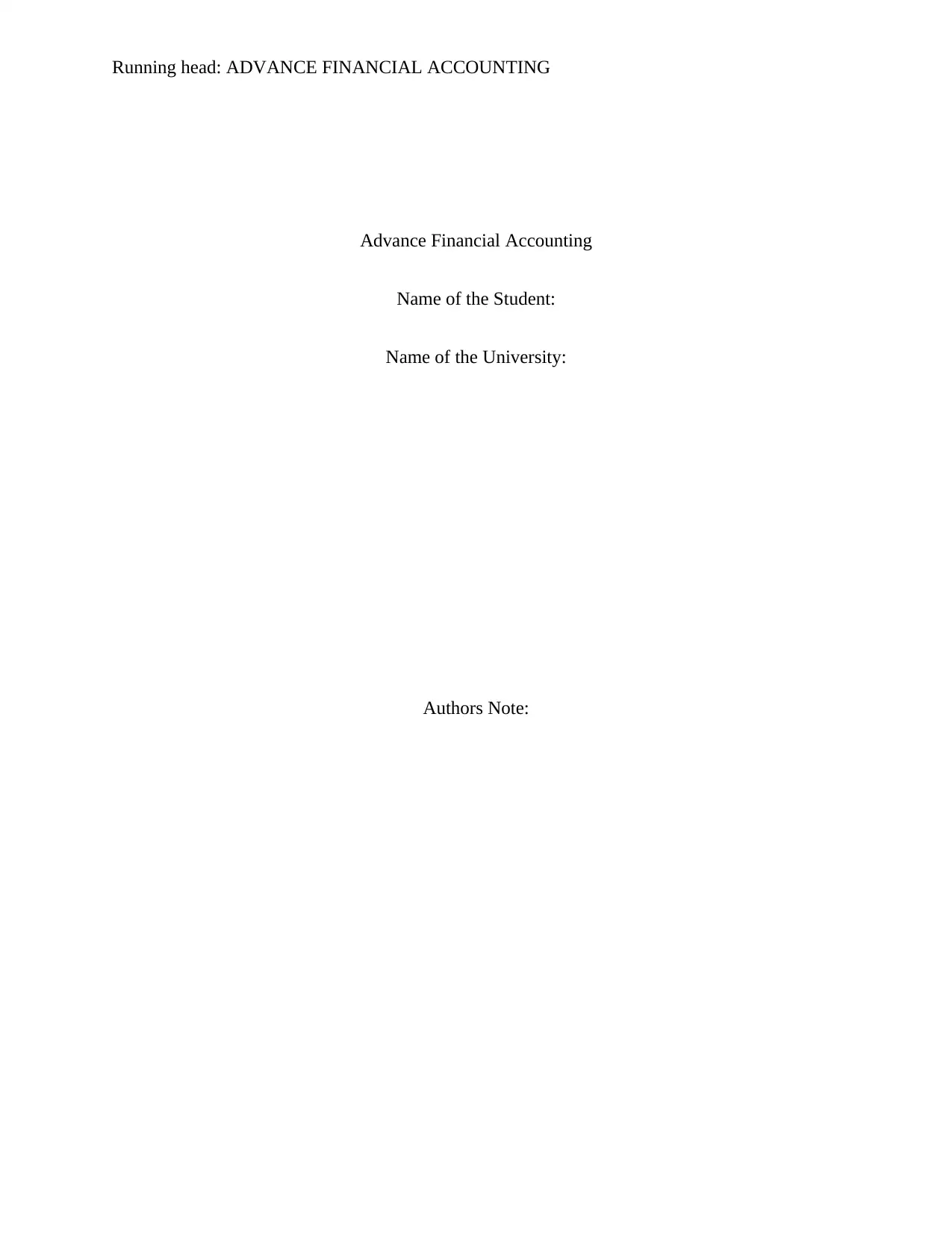
Running head: ADVANCE FINANCIAL ACCOUNTING
Advance Financial Accounting
Name of the Student:
Name of the University:
Authors Note:
Advance Financial Accounting
Name of the Student:
Name of the University:
Authors Note:
Paraphrase This Document
Need a fresh take? Get an instant paraphrase of this document with our AI Paraphraser
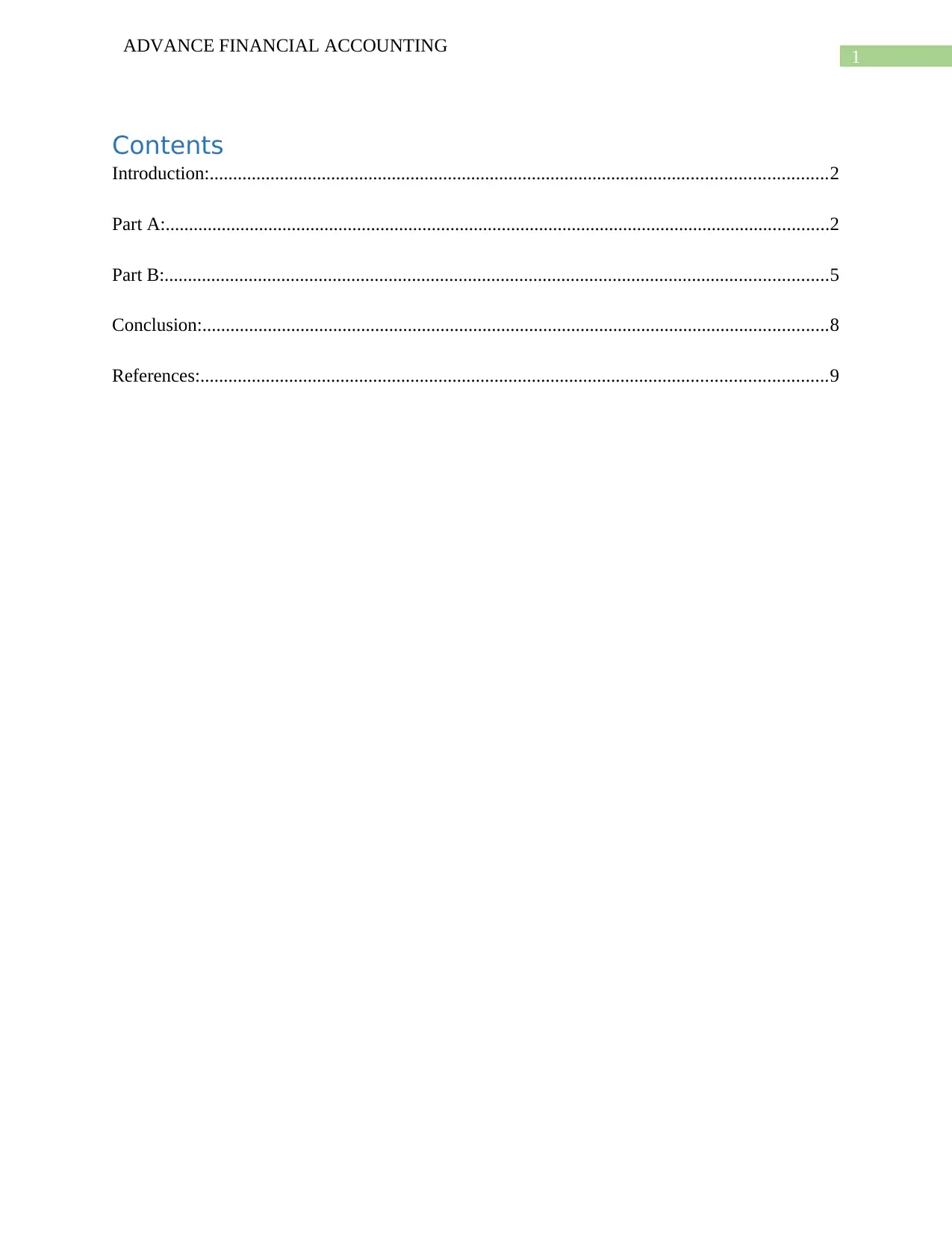
1
ADVANCE FINANCIAL ACCOUNTING
Contents
Introduction:....................................................................................................................................2
Part A:..............................................................................................................................................2
Part B:..............................................................................................................................................5
Conclusion:......................................................................................................................................8
References:......................................................................................................................................9
ADVANCE FINANCIAL ACCOUNTING
Contents
Introduction:....................................................................................................................................2
Part A:..............................................................................................................................................2
Part B:..............................................................................................................................................5
Conclusion:......................................................................................................................................8
References:......................................................................................................................................9
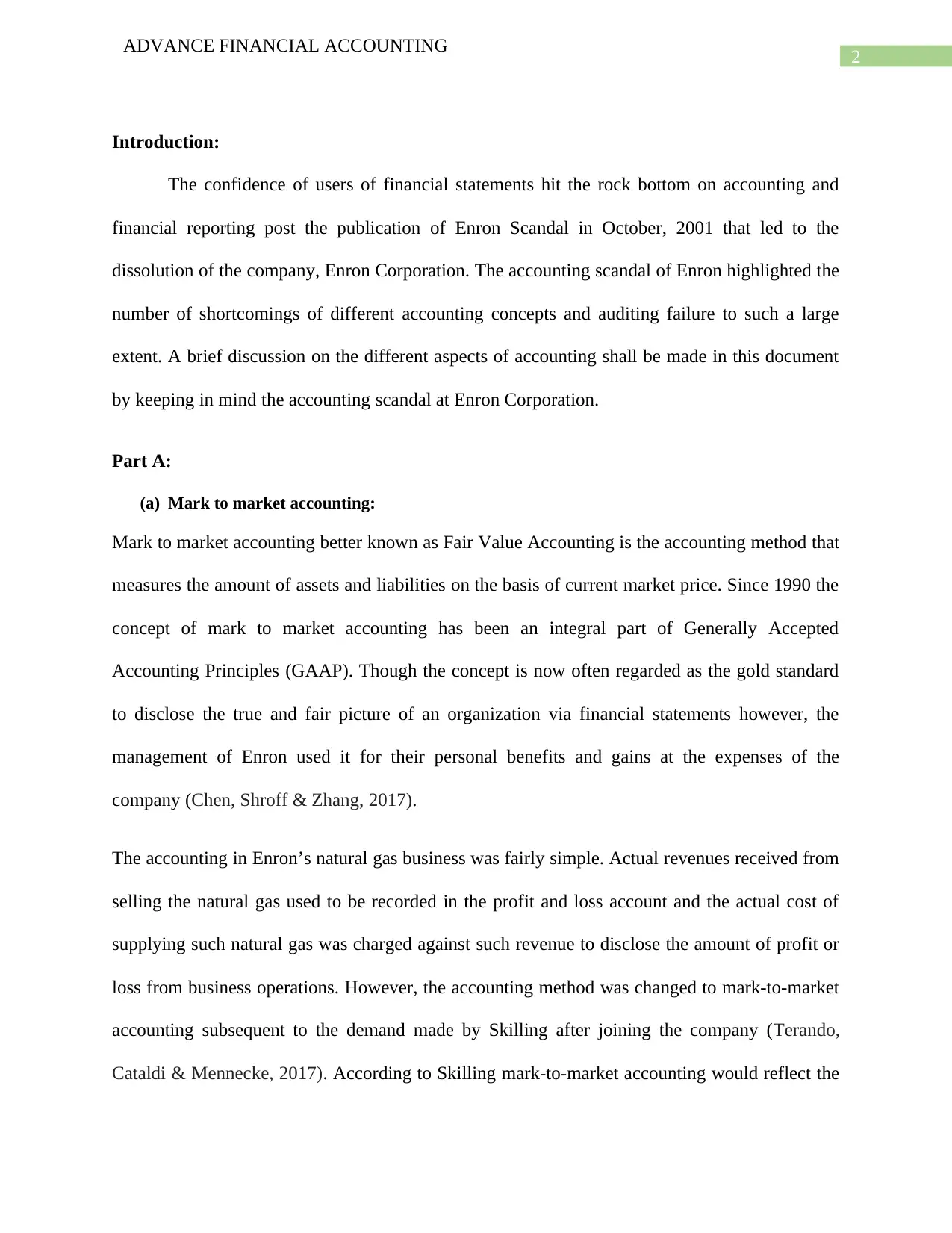
2
ADVANCE FINANCIAL ACCOUNTING
Introduction:
The confidence of users of financial statements hit the rock bottom on accounting and
financial reporting post the publication of Enron Scandal in October, 2001 that led to the
dissolution of the company, Enron Corporation. The accounting scandal of Enron highlighted the
number of shortcomings of different accounting concepts and auditing failure to such a large
extent. A brief discussion on the different aspects of accounting shall be made in this document
by keeping in mind the accounting scandal at Enron Corporation.
Part A:
(a) Mark to market accounting:
Mark to market accounting better known as Fair Value Accounting is the accounting method that
measures the amount of assets and liabilities on the basis of current market price. Since 1990 the
concept of mark to market accounting has been an integral part of Generally Accepted
Accounting Principles (GAAP). Though the concept is now often regarded as the gold standard
to disclose the true and fair picture of an organization via financial statements however, the
management of Enron used it for their personal benefits and gains at the expenses of the
company (Chen, Shroff & Zhang, 2017).
The accounting in Enron’s natural gas business was fairly simple. Actual revenues received from
selling the natural gas used to be recorded in the profit and loss account and the actual cost of
supplying such natural gas was charged against such revenue to disclose the amount of profit or
loss from business operations. However, the accounting method was changed to mark-to-market
accounting subsequent to the demand made by Skilling after joining the company (Terando,
Cataldi & Mennecke, 2017). According to Skilling mark-to-market accounting would reflect the
ADVANCE FINANCIAL ACCOUNTING
Introduction:
The confidence of users of financial statements hit the rock bottom on accounting and
financial reporting post the publication of Enron Scandal in October, 2001 that led to the
dissolution of the company, Enron Corporation. The accounting scandal of Enron highlighted the
number of shortcomings of different accounting concepts and auditing failure to such a large
extent. A brief discussion on the different aspects of accounting shall be made in this document
by keeping in mind the accounting scandal at Enron Corporation.
Part A:
(a) Mark to market accounting:
Mark to market accounting better known as Fair Value Accounting is the accounting method that
measures the amount of assets and liabilities on the basis of current market price. Since 1990 the
concept of mark to market accounting has been an integral part of Generally Accepted
Accounting Principles (GAAP). Though the concept is now often regarded as the gold standard
to disclose the true and fair picture of an organization via financial statements however, the
management of Enron used it for their personal benefits and gains at the expenses of the
company (Chen, Shroff & Zhang, 2017).
The accounting in Enron’s natural gas business was fairly simple. Actual revenues received from
selling the natural gas used to be recorded in the profit and loss account and the actual cost of
supplying such natural gas was charged against such revenue to disclose the amount of profit or
loss from business operations. However, the accounting method was changed to mark-to-market
accounting subsequent to the demand made by Skilling after joining the company (Terando,
Cataldi & Mennecke, 2017). According to Skilling mark-to-market accounting would reflect the
⊘ This is a preview!⊘
Do you want full access?
Subscribe today to unlock all pages.

Trusted by 1+ million students worldwide
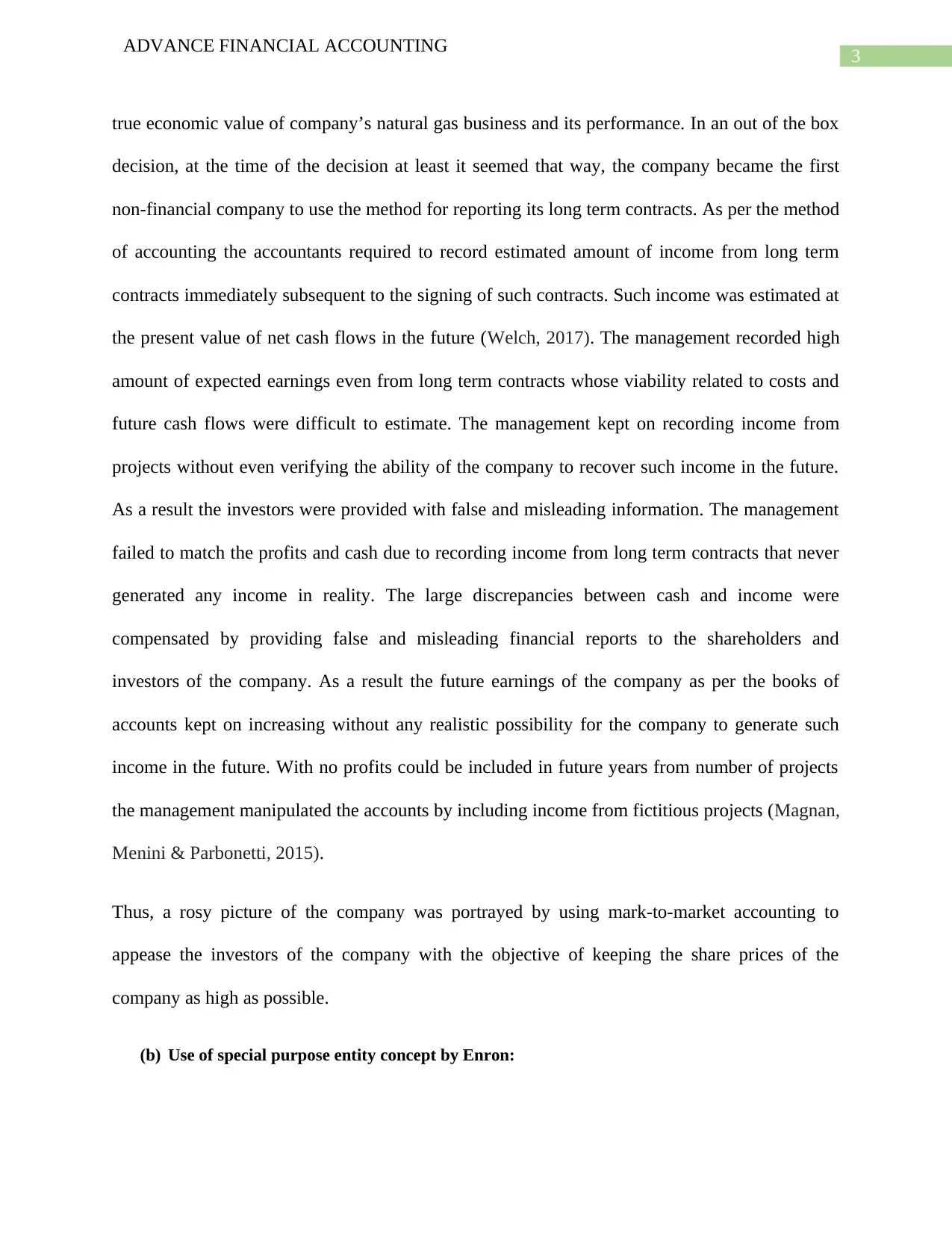
3
ADVANCE FINANCIAL ACCOUNTING
true economic value of company’s natural gas business and its performance. In an out of the box
decision, at the time of the decision at least it seemed that way, the company became the first
non-financial company to use the method for reporting its long term contracts. As per the method
of accounting the accountants required to record estimated amount of income from long term
contracts immediately subsequent to the signing of such contracts. Such income was estimated at
the present value of net cash flows in the future (Welch, 2017). The management recorded high
amount of expected earnings even from long term contracts whose viability related to costs and
future cash flows were difficult to estimate. The management kept on recording income from
projects without even verifying the ability of the company to recover such income in the future.
As a result the investors were provided with false and misleading information. The management
failed to match the profits and cash due to recording income from long term contracts that never
generated any income in reality. The large discrepancies between cash and income were
compensated by providing false and misleading financial reports to the shareholders and
investors of the company. As a result the future earnings of the company as per the books of
accounts kept on increasing without any realistic possibility for the company to generate such
income in the future. With no profits could be included in future years from number of projects
the management manipulated the accounts by including income from fictitious projects (Magnan,
Menini & Parbonetti, 2015).
Thus, a rosy picture of the company was portrayed by using mark-to-market accounting to
appease the investors of the company with the objective of keeping the share prices of the
company as high as possible.
(b) Use of special purpose entity concept by Enron:
ADVANCE FINANCIAL ACCOUNTING
true economic value of company’s natural gas business and its performance. In an out of the box
decision, at the time of the decision at least it seemed that way, the company became the first
non-financial company to use the method for reporting its long term contracts. As per the method
of accounting the accountants required to record estimated amount of income from long term
contracts immediately subsequent to the signing of such contracts. Such income was estimated at
the present value of net cash flows in the future (Welch, 2017). The management recorded high
amount of expected earnings even from long term contracts whose viability related to costs and
future cash flows were difficult to estimate. The management kept on recording income from
projects without even verifying the ability of the company to recover such income in the future.
As a result the investors were provided with false and misleading information. The management
failed to match the profits and cash due to recording income from long term contracts that never
generated any income in reality. The large discrepancies between cash and income were
compensated by providing false and misleading financial reports to the shareholders and
investors of the company. As a result the future earnings of the company as per the books of
accounts kept on increasing without any realistic possibility for the company to generate such
income in the future. With no profits could be included in future years from number of projects
the management manipulated the accounts by including income from fictitious projects (Magnan,
Menini & Parbonetti, 2015).
Thus, a rosy picture of the company was portrayed by using mark-to-market accounting to
appease the investors of the company with the objective of keeping the share prices of the
company as high as possible.
(b) Use of special purpose entity concept by Enron:
Paraphrase This Document
Need a fresh take? Get an instant paraphrase of this document with our AI Paraphraser
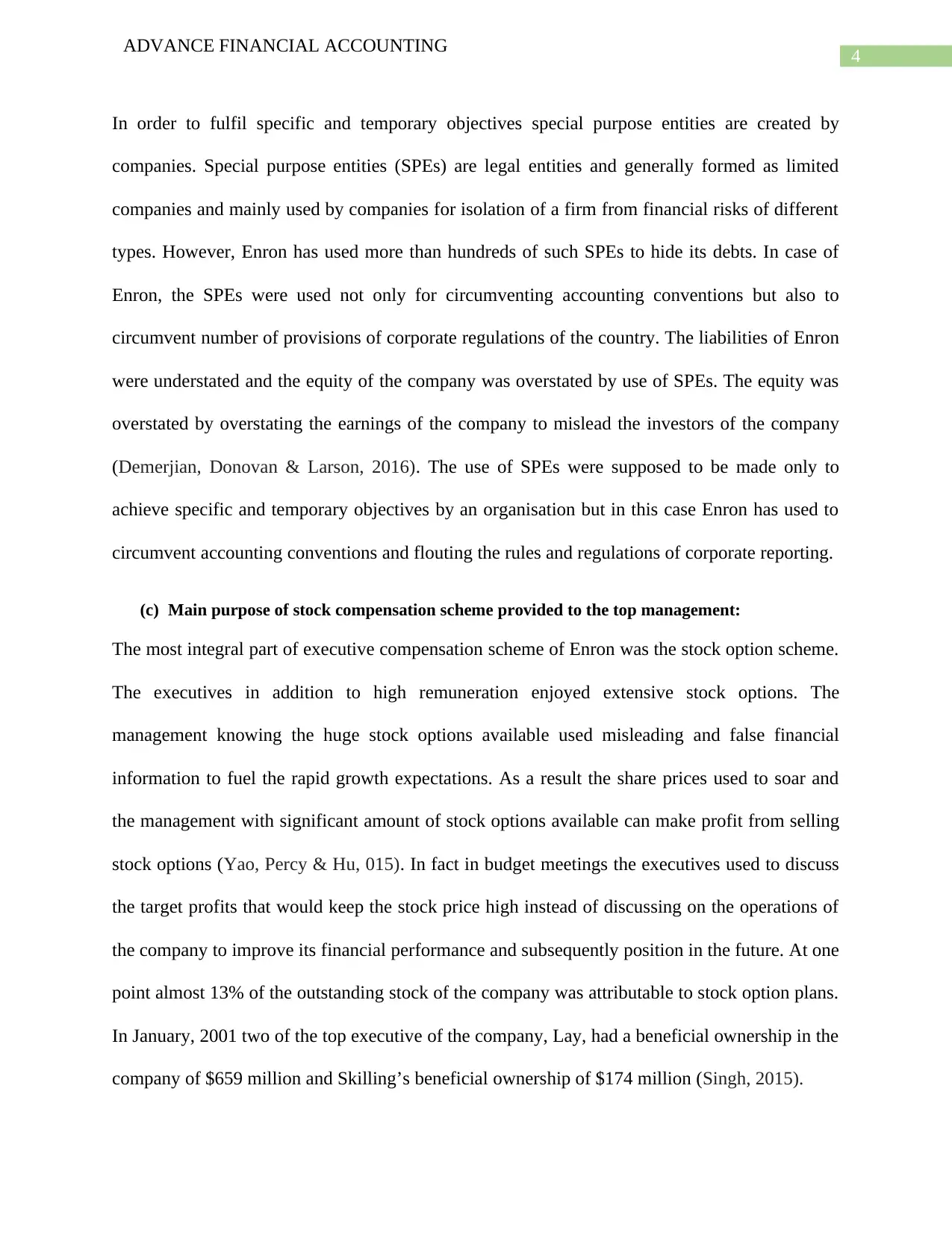
4
ADVANCE FINANCIAL ACCOUNTING
In order to fulfil specific and temporary objectives special purpose entities are created by
companies. Special purpose entities (SPEs) are legal entities and generally formed as limited
companies and mainly used by companies for isolation of a firm from financial risks of different
types. However, Enron has used more than hundreds of such SPEs to hide its debts. In case of
Enron, the SPEs were used not only for circumventing accounting conventions but also to
circumvent number of provisions of corporate regulations of the country. The liabilities of Enron
were understated and the equity of the company was overstated by use of SPEs. The equity was
overstated by overstating the earnings of the company to mislead the investors of the company
(Demerjian, Donovan & Larson, 2016). The use of SPEs were supposed to be made only to
achieve specific and temporary objectives by an organisation but in this case Enron has used to
circumvent accounting conventions and flouting the rules and regulations of corporate reporting.
(c) Main purpose of stock compensation scheme provided to the top management:
The most integral part of executive compensation scheme of Enron was the stock option scheme.
The executives in addition to high remuneration enjoyed extensive stock options. The
management knowing the huge stock options available used misleading and false financial
information to fuel the rapid growth expectations. As a result the share prices used to soar and
the management with significant amount of stock options available can make profit from selling
stock options (Yao, Percy & Hu, 015). In fact in budget meetings the executives used to discuss
the target profits that would keep the stock price high instead of discussing on the operations of
the company to improve its financial performance and subsequently position in the future. At one
point almost 13% of the outstanding stock of the company was attributable to stock option plans.
In January, 2001 two of the top executive of the company, Lay, had a beneficial ownership in the
company of $659 million and Skilling’s beneficial ownership of $174 million (Singh, 2015).
ADVANCE FINANCIAL ACCOUNTING
In order to fulfil specific and temporary objectives special purpose entities are created by
companies. Special purpose entities (SPEs) are legal entities and generally formed as limited
companies and mainly used by companies for isolation of a firm from financial risks of different
types. However, Enron has used more than hundreds of such SPEs to hide its debts. In case of
Enron, the SPEs were used not only for circumventing accounting conventions but also to
circumvent number of provisions of corporate regulations of the country. The liabilities of Enron
were understated and the equity of the company was overstated by use of SPEs. The equity was
overstated by overstating the earnings of the company to mislead the investors of the company
(Demerjian, Donovan & Larson, 2016). The use of SPEs were supposed to be made only to
achieve specific and temporary objectives by an organisation but in this case Enron has used to
circumvent accounting conventions and flouting the rules and regulations of corporate reporting.
(c) Main purpose of stock compensation scheme provided to the top management:
The most integral part of executive compensation scheme of Enron was the stock option scheme.
The executives in addition to high remuneration enjoyed extensive stock options. The
management knowing the huge stock options available used misleading and false financial
information to fuel the rapid growth expectations. As a result the share prices used to soar and
the management with significant amount of stock options available can make profit from selling
stock options (Yao, Percy & Hu, 015). In fact in budget meetings the executives used to discuss
the target profits that would keep the stock price high instead of discussing on the operations of
the company to improve its financial performance and subsequently position in the future. At one
point almost 13% of the outstanding stock of the company was attributable to stock option plans.
In January, 2001 two of the top executive of the company, Lay, had a beneficial ownership in the
company of $659 million and Skilling’s beneficial ownership of $174 million (Singh, 2015).
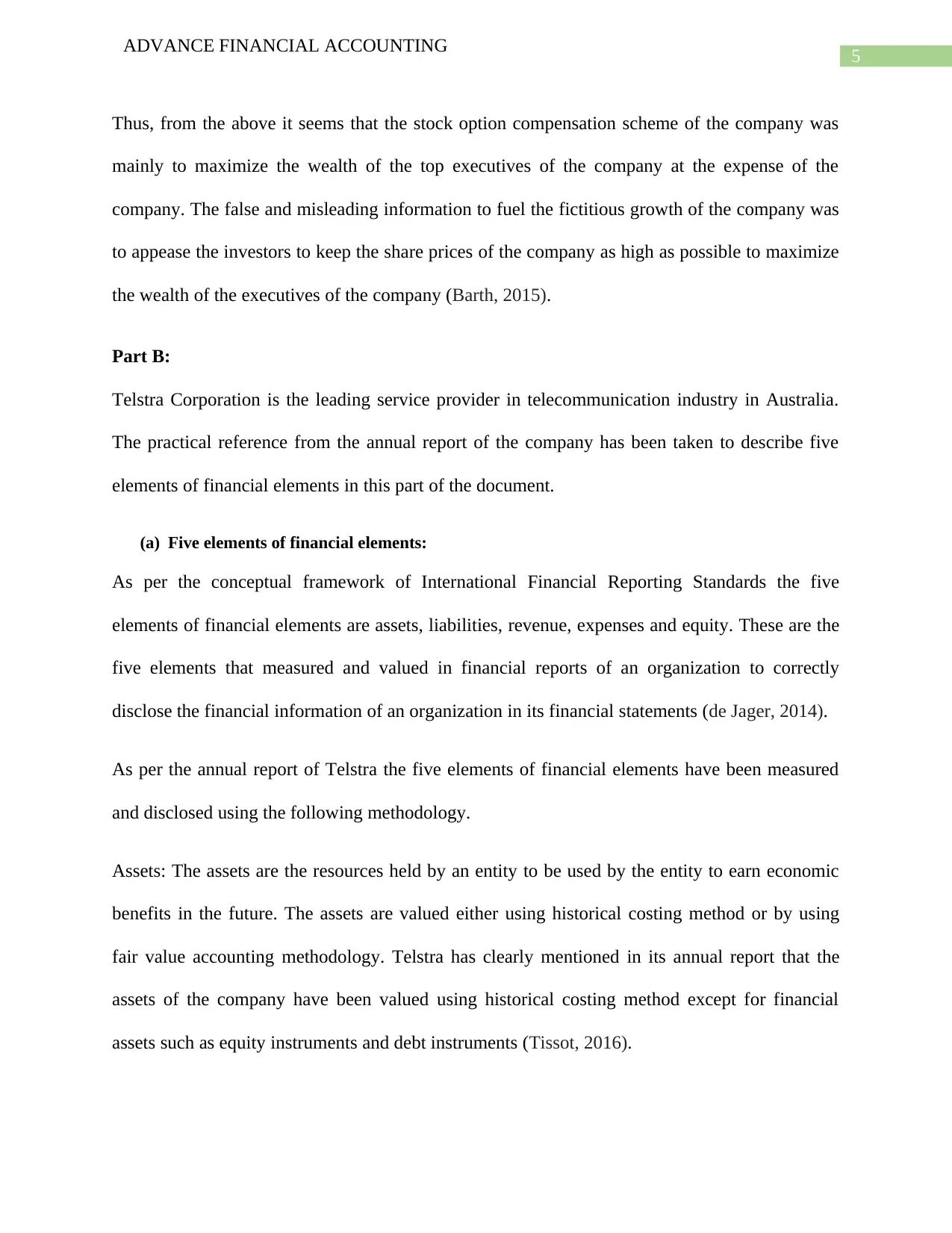
5
ADVANCE FINANCIAL ACCOUNTING
Thus, from the above it seems that the stock option compensation scheme of the company was
mainly to maximize the wealth of the top executives of the company at the expense of the
company. The false and misleading information to fuel the fictitious growth of the company was
to appease the investors to keep the share prices of the company as high as possible to maximize
the wealth of the executives of the company (Barth, 2015).
Part B:
Telstra Corporation is the leading service provider in telecommunication industry in Australia.
The practical reference from the annual report of the company has been taken to describe five
elements of financial elements in this part of the document.
(a) Five elements of financial elements:
As per the conceptual framework of International Financial Reporting Standards the five
elements of financial elements are assets, liabilities, revenue, expenses and equity. These are the
five elements that measured and valued in financial reports of an organization to correctly
disclose the financial information of an organization in its financial statements (de Jager, 2014).
As per the annual report of Telstra the five elements of financial elements have been measured
and disclosed using the following methodology.
Assets: The assets are the resources held by an entity to be used by the entity to earn economic
benefits in the future. The assets are valued either using historical costing method or by using
fair value accounting methodology. Telstra has clearly mentioned in its annual report that the
assets of the company have been valued using historical costing method except for financial
assets such as equity instruments and debt instruments (Tissot, 2016).
ADVANCE FINANCIAL ACCOUNTING
Thus, from the above it seems that the stock option compensation scheme of the company was
mainly to maximize the wealth of the top executives of the company at the expense of the
company. The false and misleading information to fuel the fictitious growth of the company was
to appease the investors to keep the share prices of the company as high as possible to maximize
the wealth of the executives of the company (Barth, 2015).
Part B:
Telstra Corporation is the leading service provider in telecommunication industry in Australia.
The practical reference from the annual report of the company has been taken to describe five
elements of financial elements in this part of the document.
(a) Five elements of financial elements:
As per the conceptual framework of International Financial Reporting Standards the five
elements of financial elements are assets, liabilities, revenue, expenses and equity. These are the
five elements that measured and valued in financial reports of an organization to correctly
disclose the financial information of an organization in its financial statements (de Jager, 2014).
As per the annual report of Telstra the five elements of financial elements have been measured
and disclosed using the following methodology.
Assets: The assets are the resources held by an entity to be used by the entity to earn economic
benefits in the future. The assets are valued either using historical costing method or by using
fair value accounting methodology. Telstra has clearly mentioned in its annual report that the
assets of the company have been valued using historical costing method except for financial
assets such as equity instruments and debt instruments (Tissot, 2016).
⊘ This is a preview!⊘
Do you want full access?
Subscribe today to unlock all pages.

Trusted by 1+ million students worldwide
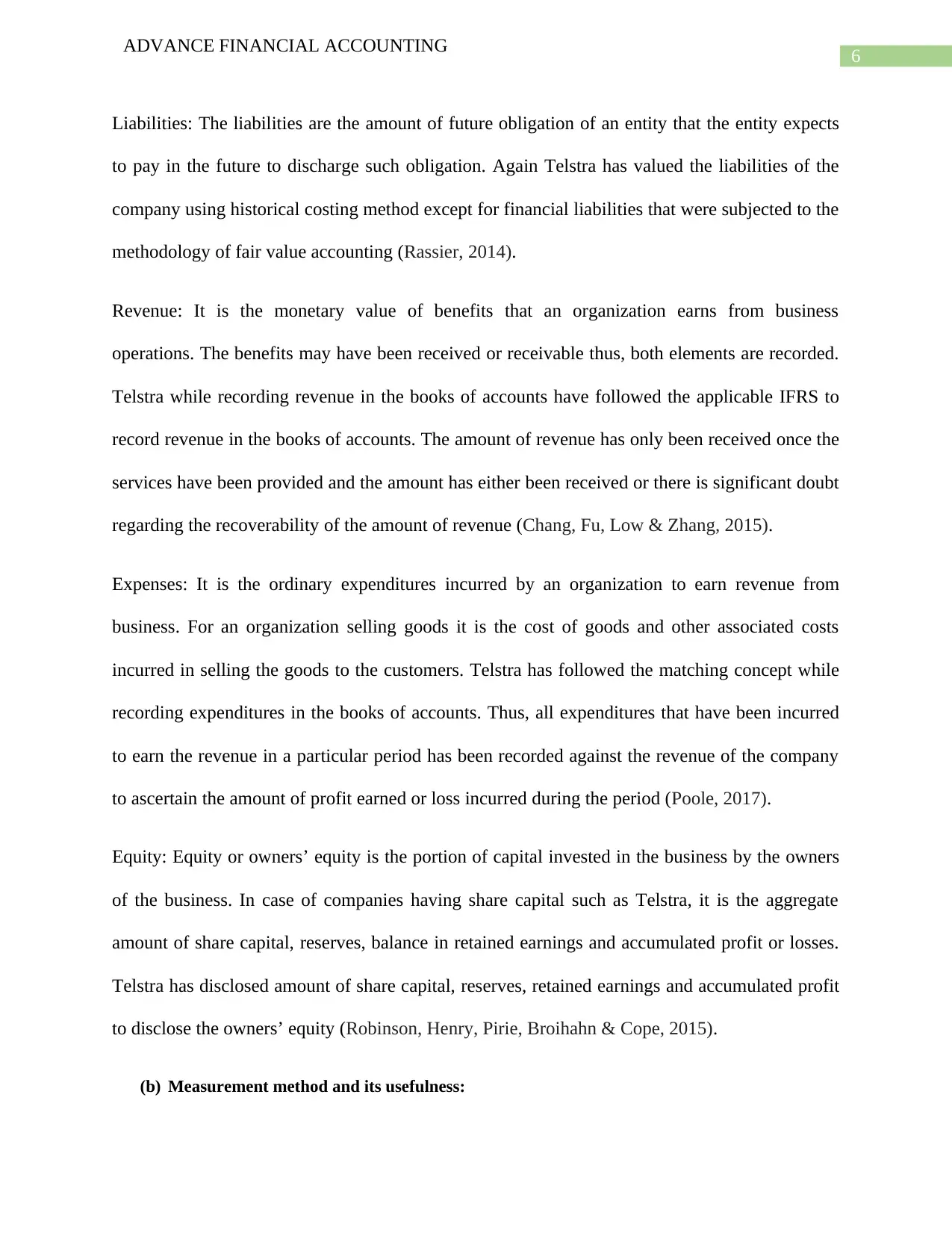
6
ADVANCE FINANCIAL ACCOUNTING
Liabilities: The liabilities are the amount of future obligation of an entity that the entity expects
to pay in the future to discharge such obligation. Again Telstra has valued the liabilities of the
company using historical costing method except for financial liabilities that were subjected to the
methodology of fair value accounting (Rassier, 2014).
Revenue: It is the monetary value of benefits that an organization earns from business
operations. The benefits may have been received or receivable thus, both elements are recorded.
Telstra while recording revenue in the books of accounts have followed the applicable IFRS to
record revenue in the books of accounts. The amount of revenue has only been received once the
services have been provided and the amount has either been received or there is significant doubt
regarding the recoverability of the amount of revenue (Chang, Fu, Low & Zhang, 2015).
Expenses: It is the ordinary expenditures incurred by an organization to earn revenue from
business. For an organization selling goods it is the cost of goods and other associated costs
incurred in selling the goods to the customers. Telstra has followed the matching concept while
recording expenditures in the books of accounts. Thus, all expenditures that have been incurred
to earn the revenue in a particular period has been recorded against the revenue of the company
to ascertain the amount of profit earned or loss incurred during the period (Poole, 2017).
Equity: Equity or owners’ equity is the portion of capital invested in the business by the owners
of the business. In case of companies having share capital such as Telstra, it is the aggregate
amount of share capital, reserves, balance in retained earnings and accumulated profit or losses.
Telstra has disclosed amount of share capital, reserves, retained earnings and accumulated profit
to disclose the owners’ equity (Robinson, Henry, Pirie, Broihahn & Cope, 2015).
(b) Measurement method and its usefulness:
ADVANCE FINANCIAL ACCOUNTING
Liabilities: The liabilities are the amount of future obligation of an entity that the entity expects
to pay in the future to discharge such obligation. Again Telstra has valued the liabilities of the
company using historical costing method except for financial liabilities that were subjected to the
methodology of fair value accounting (Rassier, 2014).
Revenue: It is the monetary value of benefits that an organization earns from business
operations. The benefits may have been received or receivable thus, both elements are recorded.
Telstra while recording revenue in the books of accounts have followed the applicable IFRS to
record revenue in the books of accounts. The amount of revenue has only been received once the
services have been provided and the amount has either been received or there is significant doubt
regarding the recoverability of the amount of revenue (Chang, Fu, Low & Zhang, 2015).
Expenses: It is the ordinary expenditures incurred by an organization to earn revenue from
business. For an organization selling goods it is the cost of goods and other associated costs
incurred in selling the goods to the customers. Telstra has followed the matching concept while
recording expenditures in the books of accounts. Thus, all expenditures that have been incurred
to earn the revenue in a particular period has been recorded against the revenue of the company
to ascertain the amount of profit earned or loss incurred during the period (Poole, 2017).
Equity: Equity or owners’ equity is the portion of capital invested in the business by the owners
of the business. In case of companies having share capital such as Telstra, it is the aggregate
amount of share capital, reserves, balance in retained earnings and accumulated profit or losses.
Telstra has disclosed amount of share capital, reserves, retained earnings and accumulated profit
to disclose the owners’ equity (Robinson, Henry, Pirie, Broihahn & Cope, 2015).
(b) Measurement method and its usefulness:
Paraphrase This Document
Need a fresh take? Get an instant paraphrase of this document with our AI Paraphraser
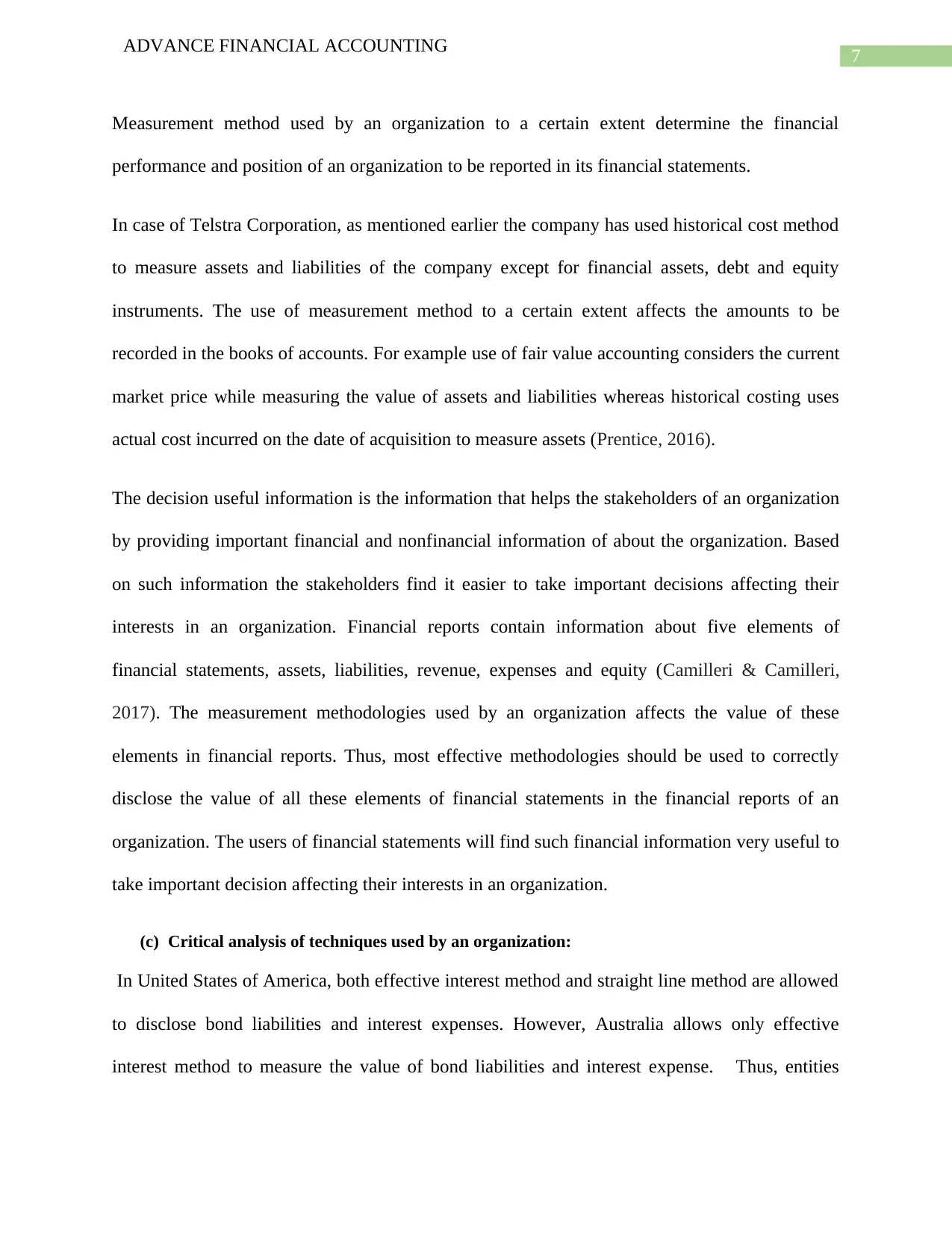
7
ADVANCE FINANCIAL ACCOUNTING
Measurement method used by an organization to a certain extent determine the financial
performance and position of an organization to be reported in its financial statements.
In case of Telstra Corporation, as mentioned earlier the company has used historical cost method
to measure assets and liabilities of the company except for financial assets, debt and equity
instruments. The use of measurement method to a certain extent affects the amounts to be
recorded in the books of accounts. For example use of fair value accounting considers the current
market price while measuring the value of assets and liabilities whereas historical costing uses
actual cost incurred on the date of acquisition to measure assets (Prentice, 2016).
The decision useful information is the information that helps the stakeholders of an organization
by providing important financial and nonfinancial information of about the organization. Based
on such information the stakeholders find it easier to take important decisions affecting their
interests in an organization. Financial reports contain information about five elements of
financial statements, assets, liabilities, revenue, expenses and equity (Camilleri & Camilleri,
2017). The measurement methodologies used by an organization affects the value of these
elements in financial reports. Thus, most effective methodologies should be used to correctly
disclose the value of all these elements of financial statements in the financial reports of an
organization. The users of financial statements will find such financial information very useful to
take important decision affecting their interests in an organization.
(c) Critical analysis of techniques used by an organization:
In United States of America, both effective interest method and straight line method are allowed
to disclose bond liabilities and interest expenses. However, Australia allows only effective
interest method to measure the value of bond liabilities and interest expense. Thus, entities
ADVANCE FINANCIAL ACCOUNTING
Measurement method used by an organization to a certain extent determine the financial
performance and position of an organization to be reported in its financial statements.
In case of Telstra Corporation, as mentioned earlier the company has used historical cost method
to measure assets and liabilities of the company except for financial assets, debt and equity
instruments. The use of measurement method to a certain extent affects the amounts to be
recorded in the books of accounts. For example use of fair value accounting considers the current
market price while measuring the value of assets and liabilities whereas historical costing uses
actual cost incurred on the date of acquisition to measure assets (Prentice, 2016).
The decision useful information is the information that helps the stakeholders of an organization
by providing important financial and nonfinancial information of about the organization. Based
on such information the stakeholders find it easier to take important decisions affecting their
interests in an organization. Financial reports contain information about five elements of
financial statements, assets, liabilities, revenue, expenses and equity (Camilleri & Camilleri,
2017). The measurement methodologies used by an organization affects the value of these
elements in financial reports. Thus, most effective methodologies should be used to correctly
disclose the value of all these elements of financial statements in the financial reports of an
organization. The users of financial statements will find such financial information very useful to
take important decision affecting their interests in an organization.
(c) Critical analysis of techniques used by an organization:
In United States of America, both effective interest method and straight line method are allowed
to disclose bond liabilities and interest expenses. However, Australia allows only effective
interest method to measure the value of bond liabilities and interest expense. Thus, entities
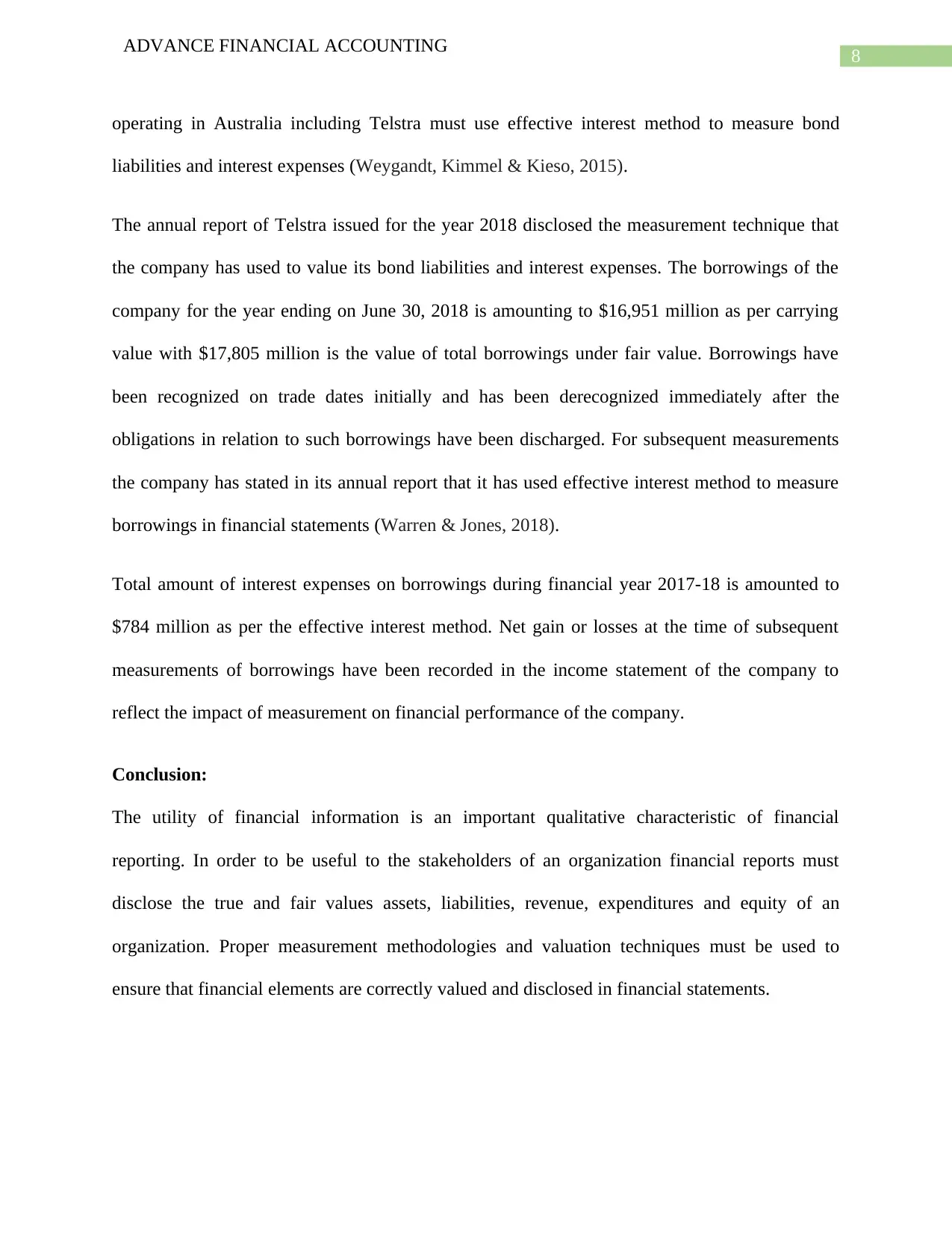
8
ADVANCE FINANCIAL ACCOUNTING
operating in Australia including Telstra must use effective interest method to measure bond
liabilities and interest expenses (Weygandt, Kimmel & Kieso, 2015).
The annual report of Telstra issued for the year 2018 disclosed the measurement technique that
the company has used to value its bond liabilities and interest expenses. The borrowings of the
company for the year ending on June 30, 2018 is amounting to $16,951 million as per carrying
value with $17,805 million is the value of total borrowings under fair value. Borrowings have
been recognized on trade dates initially and has been derecognized immediately after the
obligations in relation to such borrowings have been discharged. For subsequent measurements
the company has stated in its annual report that it has used effective interest method to measure
borrowings in financial statements (Warren & Jones, 2018).
Total amount of interest expenses on borrowings during financial year 2017-18 is amounted to
$784 million as per the effective interest method. Net gain or losses at the time of subsequent
measurements of borrowings have been recorded in the income statement of the company to
reflect the impact of measurement on financial performance of the company.
Conclusion:
The utility of financial information is an important qualitative characteristic of financial
reporting. In order to be useful to the stakeholders of an organization financial reports must
disclose the true and fair values assets, liabilities, revenue, expenditures and equity of an
organization. Proper measurement methodologies and valuation techniques must be used to
ensure that financial elements are correctly valued and disclosed in financial statements.
ADVANCE FINANCIAL ACCOUNTING
operating in Australia including Telstra must use effective interest method to measure bond
liabilities and interest expenses (Weygandt, Kimmel & Kieso, 2015).
The annual report of Telstra issued for the year 2018 disclosed the measurement technique that
the company has used to value its bond liabilities and interest expenses. The borrowings of the
company for the year ending on June 30, 2018 is amounting to $16,951 million as per carrying
value with $17,805 million is the value of total borrowings under fair value. Borrowings have
been recognized on trade dates initially and has been derecognized immediately after the
obligations in relation to such borrowings have been discharged. For subsequent measurements
the company has stated in its annual report that it has used effective interest method to measure
borrowings in financial statements (Warren & Jones, 2018).
Total amount of interest expenses on borrowings during financial year 2017-18 is amounted to
$784 million as per the effective interest method. Net gain or losses at the time of subsequent
measurements of borrowings have been recorded in the income statement of the company to
reflect the impact of measurement on financial performance of the company.
Conclusion:
The utility of financial information is an important qualitative characteristic of financial
reporting. In order to be useful to the stakeholders of an organization financial reports must
disclose the true and fair values assets, liabilities, revenue, expenditures and equity of an
organization. Proper measurement methodologies and valuation techniques must be used to
ensure that financial elements are correctly valued and disclosed in financial statements.
⊘ This is a preview!⊘
Do you want full access?
Subscribe today to unlock all pages.

Trusted by 1+ million students worldwide
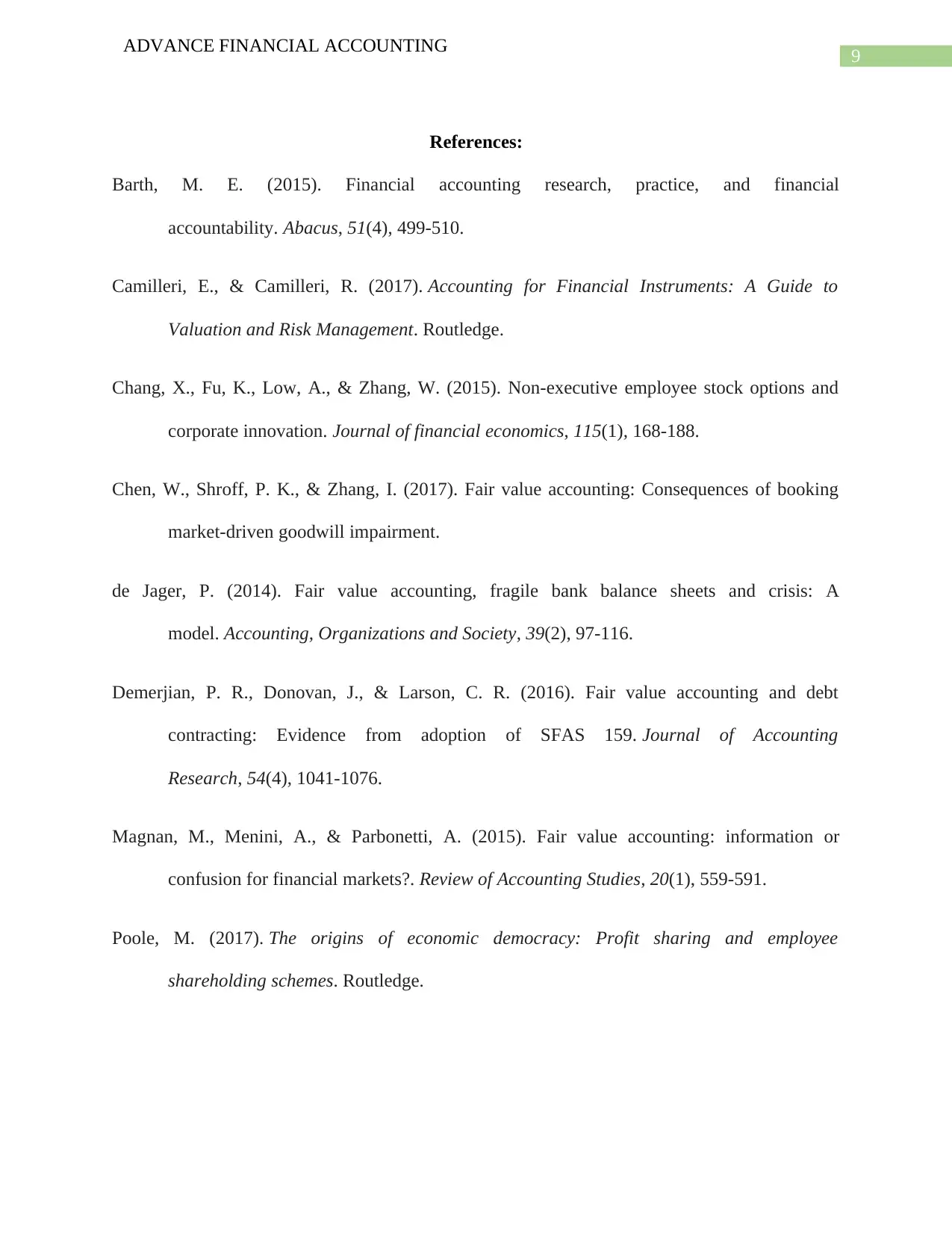
9
ADVANCE FINANCIAL ACCOUNTING
References:
Barth, M. E. (2015). Financial accounting research, practice, and financial
accountability. Abacus, 51(4), 499-510.
Camilleri, E., & Camilleri, R. (2017). Accounting for Financial Instruments: A Guide to
Valuation and Risk Management. Routledge.
Chang, X., Fu, K., Low, A., & Zhang, W. (2015). Non-executive employee stock options and
corporate innovation. Journal of financial economics, 115(1), 168-188.
Chen, W., Shroff, P. K., & Zhang, I. (2017). Fair value accounting: Consequences of booking
market-driven goodwill impairment.
de Jager, P. (2014). Fair value accounting, fragile bank balance sheets and crisis: A
model. Accounting, Organizations and Society, 39(2), 97-116.
Demerjian, P. R., Donovan, J., & Larson, C. R. (2016). Fair value accounting and debt
contracting: Evidence from adoption of SFAS 159. Journal of Accounting
Research, 54(4), 1041-1076.
Magnan, M., Menini, A., & Parbonetti, A. (2015). Fair value accounting: information or
confusion for financial markets?. Review of Accounting Studies, 20(1), 559-591.
Poole, M. (2017). The origins of economic democracy: Profit sharing and employee
shareholding schemes. Routledge.
ADVANCE FINANCIAL ACCOUNTING
References:
Barth, M. E. (2015). Financial accounting research, practice, and financial
accountability. Abacus, 51(4), 499-510.
Camilleri, E., & Camilleri, R. (2017). Accounting for Financial Instruments: A Guide to
Valuation and Risk Management. Routledge.
Chang, X., Fu, K., Low, A., & Zhang, W. (2015). Non-executive employee stock options and
corporate innovation. Journal of financial economics, 115(1), 168-188.
Chen, W., Shroff, P. K., & Zhang, I. (2017). Fair value accounting: Consequences of booking
market-driven goodwill impairment.
de Jager, P. (2014). Fair value accounting, fragile bank balance sheets and crisis: A
model. Accounting, Organizations and Society, 39(2), 97-116.
Demerjian, P. R., Donovan, J., & Larson, C. R. (2016). Fair value accounting and debt
contracting: Evidence from adoption of SFAS 159. Journal of Accounting
Research, 54(4), 1041-1076.
Magnan, M., Menini, A., & Parbonetti, A. (2015). Fair value accounting: information or
confusion for financial markets?. Review of Accounting Studies, 20(1), 559-591.
Poole, M. (2017). The origins of economic democracy: Profit sharing and employee
shareholding schemes. Routledge.
Paraphrase This Document
Need a fresh take? Get an instant paraphrase of this document with our AI Paraphraser
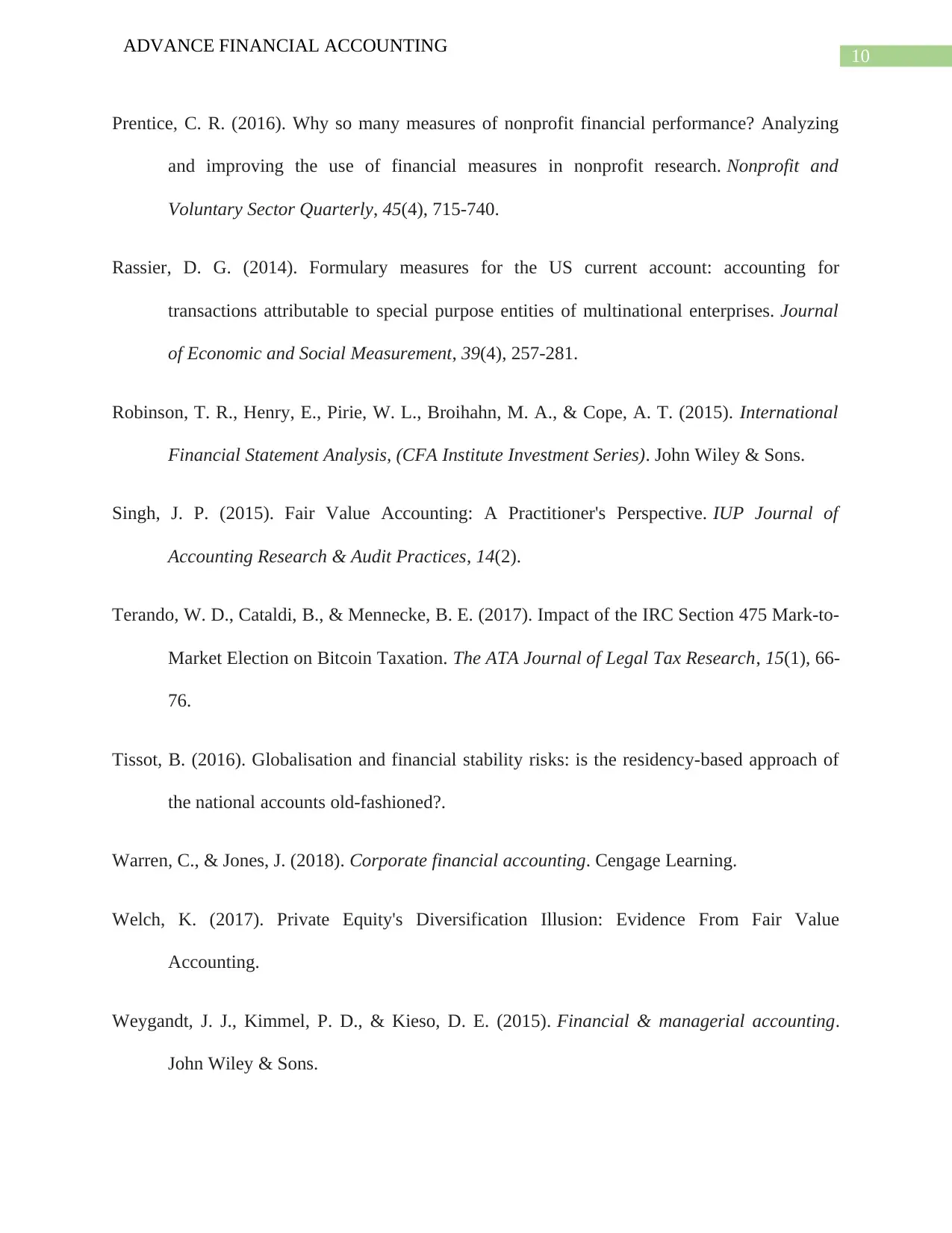
10
ADVANCE FINANCIAL ACCOUNTING
Prentice, C. R. (2016). Why so many measures of nonprofit financial performance? Analyzing
and improving the use of financial measures in nonprofit research. Nonprofit and
Voluntary Sector Quarterly, 45(4), 715-740.
Rassier, D. G. (2014). Formulary measures for the US current account: accounting for
transactions attributable to special purpose entities of multinational enterprises. Journal
of Economic and Social Measurement, 39(4), 257-281.
Robinson, T. R., Henry, E., Pirie, W. L., Broihahn, M. A., & Cope, A. T. (2015). International
Financial Statement Analysis, (CFA Institute Investment Series). John Wiley & Sons.
Singh, J. P. (2015). Fair Value Accounting: A Practitioner's Perspective. IUP Journal of
Accounting Research & Audit Practices, 14(2).
Terando, W. D., Cataldi, B., & Mennecke, B. E. (2017). Impact of the IRC Section 475 Mark-to-
Market Election on Bitcoin Taxation. The ATA Journal of Legal Tax Research, 15(1), 66-
76.
Tissot, B. (2016). Globalisation and financial stability risks: is the residency-based approach of
the national accounts old-fashioned?.
Warren, C., & Jones, J. (2018). Corporate financial accounting. Cengage Learning.
Welch, K. (2017). Private Equity's Diversification Illusion: Evidence From Fair Value
Accounting.
Weygandt, J. J., Kimmel, P. D., & Kieso, D. E. (2015). Financial & managerial accounting.
John Wiley & Sons.
ADVANCE FINANCIAL ACCOUNTING
Prentice, C. R. (2016). Why so many measures of nonprofit financial performance? Analyzing
and improving the use of financial measures in nonprofit research. Nonprofit and
Voluntary Sector Quarterly, 45(4), 715-740.
Rassier, D. G. (2014). Formulary measures for the US current account: accounting for
transactions attributable to special purpose entities of multinational enterprises. Journal
of Economic and Social Measurement, 39(4), 257-281.
Robinson, T. R., Henry, E., Pirie, W. L., Broihahn, M. A., & Cope, A. T. (2015). International
Financial Statement Analysis, (CFA Institute Investment Series). John Wiley & Sons.
Singh, J. P. (2015). Fair Value Accounting: A Practitioner's Perspective. IUP Journal of
Accounting Research & Audit Practices, 14(2).
Terando, W. D., Cataldi, B., & Mennecke, B. E. (2017). Impact of the IRC Section 475 Mark-to-
Market Election on Bitcoin Taxation. The ATA Journal of Legal Tax Research, 15(1), 66-
76.
Tissot, B. (2016). Globalisation and financial stability risks: is the residency-based approach of
the national accounts old-fashioned?.
Warren, C., & Jones, J. (2018). Corporate financial accounting. Cengage Learning.
Welch, K. (2017). Private Equity's Diversification Illusion: Evidence From Fair Value
Accounting.
Weygandt, J. J., Kimmel, P. D., & Kieso, D. E. (2015). Financial & managerial accounting.
John Wiley & Sons.
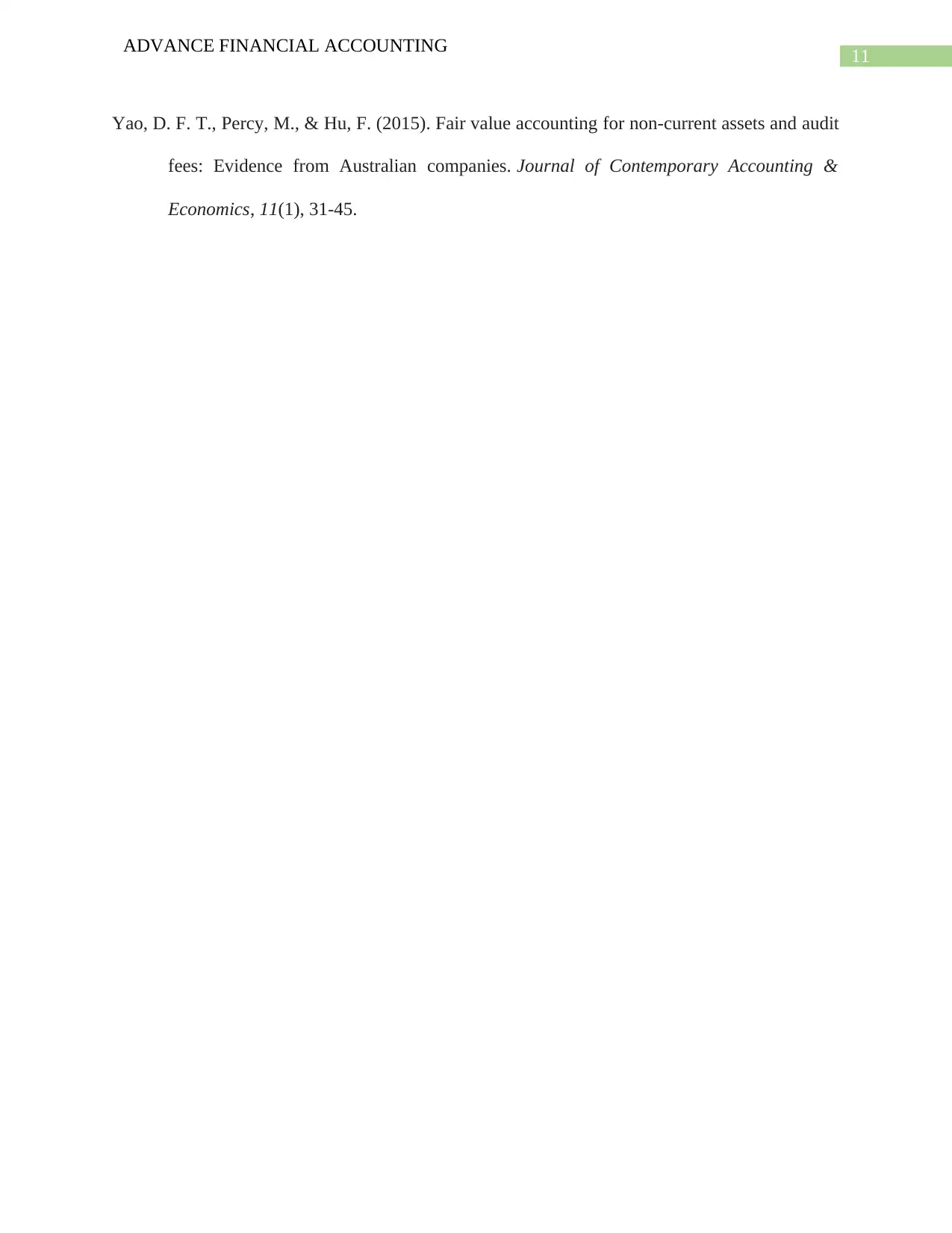
11
ADVANCE FINANCIAL ACCOUNTING
Yao, D. F. T., Percy, M., & Hu, F. (2015). Fair value accounting for non-current assets and audit
fees: Evidence from Australian companies. Journal of Contemporary Accounting &
Economics, 11(1), 31-45.
ADVANCE FINANCIAL ACCOUNTING
Yao, D. F. T., Percy, M., & Hu, F. (2015). Fair value accounting for non-current assets and audit
fees: Evidence from Australian companies. Journal of Contemporary Accounting &
Economics, 11(1), 31-45.
⊘ This is a preview!⊘
Do you want full access?
Subscribe today to unlock all pages.

Trusted by 1+ million students worldwide
1 out of 12
Related Documents
Your All-in-One AI-Powered Toolkit for Academic Success.
+13062052269
info@desklib.com
Available 24*7 on WhatsApp / Email
![[object Object]](/_next/static/media/star-bottom.7253800d.svg)
Unlock your academic potential
Copyright © 2020–2025 A2Z Services. All Rights Reserved. Developed and managed by ZUCOL.




